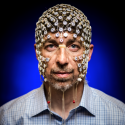Genetic change prevents cell death in mouse model of Parkinson’s disease
By shifting a normal protective mechanism into overdrive, A University of Wisconsin–Madison scientist has completely shielded mice from a toxic chemical that would otherwise cause Parkinson’s disease.
Parkinson’s disease is a disabling and sometimes fatal disease that afflicts 1.5 million Americans, with about 60,000 new cases annually. Its major symptoms, including tremors and sluggish movement, have been traced to death of small numbers of nerve cells in the substantia nigra, a brain region that helps regulate movement.
In a study published in today’s Proceedings of the National Academy of Sciences, Jeffrey Johnson, a professor in the School of Pharmacy, reported that adding extra copies of a gene that makes a protective protein prevented a toxic chemical from devastating the substantia nigra.
“This complete abolition of toxicity was far greater than we expected,” says Johnson. “It was striking; we thought we would see a 20 or 30 or 40 percent reduction in cell death.”
The protective mechanism is initiated by a protein called Nrf2, which is present in people and in mice, says Johnson, who is also an investigator at the University’s Waisman Center. Nrf2 (transcription factor NF-E2-related factor) is made by astrocytes, brain cells that play a supportive role to the neurons, which are the cells that actually carry nerve signals.
In recent years, researchers looking at several neurodegenerative diseases, including Alzheimer’s and Lou Gehrig’s diseases as well as Parkinson’s, have focused on the astrocytes in their quest to help the brain protect itself from stressful conditions that are deadly to neurons.
“Astrocytes equal or outnumber neurons and are found throughout the central nervous system,” says Johnson. “Neurons have always gotten the Academy Awards, but astrocyte dysfunction is becoming a central theme in neurodegenerative disease. If we can figure out how to fix a sick astrocyte, or even prevent it from getting sick, that could offer profound protection against numerous neurodegenerative diseases.”
Because neurons are extremely difficult to replace, the present research focus in neurodegenerative disease is on preventing their death in the first place. Parkinson’s disease can be treated for a time by replacing dopamine, the brain chemical made by the substantia nigra, but the treatment loses its efficacy over time.
Johnson and lead author Pei-Chun Chen, a postdoctoral fellow in the Johnson laboratory, studied mice with extra Nrf2 genes. The astrocytes in these mice produced about twice the normal level of Nrf2 protein.
The researchers then dosed the mice with MPTP, a chemical that kills neurons in the substantia nigra and has become a major mechanism for modeling Parkinson’s disease in mice.
The toxicity of MPTP was discovered in 1982, when young drug users in California developed the classic symptoms of Parkinson’s disease, which is rare among those younger than 60. Researchers found that these people had used a synthetic heroin contaminated with MPTP, which further studies found is highly toxic to nerve cells in the substantia nigra.
When astrocytes make Nrf2, the protein attaches to their DNA, kick-starting activity in hundreds of genes that make and release proteins that can protect nearby neurons from oxidation – a series of chemical reactions that can injure or kill cells.
“The astrocytes are also probably sucking up the bad stuff, thereby reducing the oxidative environment and stress on the neurons,” says Johnson, adding that his laboratory is trying to identify those specific protective molecules.
Nobody can predict when a manipulation of Nrf2 could reach clinical trials, which Johnson says are at the very least three years in the future. While the experimenters altered the mouse cells via genetic engineering, human trials would probably use drugs to boost Nrf2 production in astrocytes. Several labs, including Johnson’s, are already searching for candidate drugs.
The stakes are high, Johnson says, because Nrf2 also protects brain cells in models of such fatal brain diseases as Alzheimer’s, ALS (amyotrophic lateral sclerosis, or Lou Gehrig’s disease), and Huntington’s disease.
Normally, neurons “commit suicide”, in these neurodegenerative diseases through a process called programmed cell death, Johnson says. “Nrf2 seems to rebalance the system in favor of what we call programmed cell life.”
Marcelo Vargas, Amar Pani, Richard Smeyne, Delinda Johnson and Yuet Wai Kan were also part of this collaborative research team from the University of Wisconsin, St. Jude Children’s Research Hospital and the University of California-San Francisco. The research was funded by the National Institute of Environmental Health Sciences.



